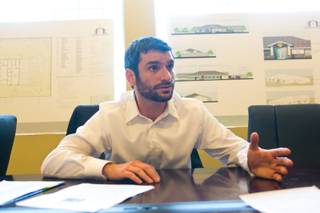
The William Fry Drop In Center has a full kitchen available to homeless youth, Tuesday Jan. 29, 2013.
Sunday, Feb. 3, 2013 | 2 a.m.
On a recent weekday afternoon at the William Fry Drop-In Center near UNLV’s campus, two teenagers lounged on oversized bean bags while watching television.
As Arash Ghafoori passes through the common area, he greets the teens and asks what they thought of the Lady Gaga concert they’d seen over the weekend at MGM Grand Garden Arena.
The pop star donated tickets to the Nevada Partnership for Homeless Youth, which runs the drop-in center, and several of the teens the nonprofit agency helps were able to attend.
As the teens voiced their approval of Lady Gaga, Ghafoori, executive director of the partnership, smiled and continued toward a conference room in the back of the building.
Along the way, he passed a kitchen stocked with frozen meals and a large clothes pantry filled with laundry facilities, toiletries and racks of clothes for use by the hundreds of teens the nonprofit serves.
The agency was founded 13 years ago. Its programs include short- and long-term housing for homeless teens, street outreach, family reunification services, and operating a network of certified Safe Places at convenience stores and other locations around the valley where teens in crisis can go.
The drop-in center acts as the bustling hub of the agency’s efforts to provide support services to Las Vegas’s growing homeless youth population, but its existence was threatened early last year when scandal engulfed it and nearly put it out of business.
“At first, there were so many unknowns. It was very scary,” Ghafoori said. “It was extremely nerve-wracking to see the mission here threatened and to even fathom the possibility of having to shut the doors, having to figure out where these kids are going to go.”
In December 2011, Ghafoori, who had been named executive director four months earlier, questioned how founder Kathleen Vermillion was spending the charity’s money at its sister organization, the Homeless Youth Foundation, which was created to raise donations for the partnership.
The complaint prompted an investigation by the Nevada Attorney General’s Office and, later, the FBI into the two agencies’ finances, leading to Vermillion’s firing in January. Vermillion also resigned from her seat on the Henderson City Council as she became a target of scrutiny.
A financial audit completed several months later revealed several instances of questionable spending by the foundation, including missing invoices, ATM withdrawals and airline tickets for nonbusiness trips.
Vermillion has denied wrongdoing on her part and has filed a defamation suit against Ghafoori, the partnership and the foundation. She declined through an attorney to comment for this article.
The scandal left the partnership reeling as its reputation suffered and donors began asking for refunds.
“We had funding partners that were very concerned when the debacle happened. A lot of our assets were frozen,” Ghafoori said. “We already had bills to pay, things to do. We came very close to not having the money to make everything happen. Our No. 1 goal was to make sure the kids didn’t become victims of a management situation.”
Nonprofit agencies are especially vulnerable to scandals because they rely on their reputation to generate support in the public, said Christine Springer, a UNLV professor with expertise on nonprofit agencies.
Many such agencies fail to recover from financial scandals; those that do must be upfront about the wrongdoing and transparent about what steps are being taken to fix the problem.
“Nonprofits are more vulnerable to public scrutiny in many respects … because they use donations that people make and (donors) expect their money to be used wisely,” Springer said.
With Vermillion out of the picture and the scandal quieting, Ghafoori went to work reforming operations and wooing back donors.
Drawing on his background as a private-sector consultant, Ghafoori aimed to make the partnership more businesslike and increase financial transparency. He put in place new systems to document how money was being spent and what outcomes were achieved to prove to donors the work the partnership did was worth investing in.
The effort has largely paid off — after months of “triage,” Ghafoori happily reports the partnership lost just one donor of $100 in the past year while many of its existing donors have increased their contributions.
The number of youths served in the past year has increased by 123 and the partnership’s intensive transitional living program has seen higher graduation rates.
The agency also has partnered with UNLV and recently received a $500,000 federal grant through Clark County, which only nine months earlier had considered cutting its funding in the immediate wake of the controversy.
“When it first blew up last year, our staff (investigated), at our direction, and we found that there were weaknesses and flaws in their financing. Things were not properly allocated, some were duplicated,” Commissioner Chris Giunchigliani said. “I had concerns, several of us did, about the federal grant, so we asked questions. … (The partnership) assured us at our board meeting when that grant was awarded that they will have to report back (to staff) monthly. If there are any problems, they will have to come back to the board and we can sever the grant.”
Although Vermillion’s lawsuit and the attorney general and FBI investigations still loom over the partnership, Ghafoori said he’s sleeping much easier these days and was keeping his eye on expanding the agency.
He plans to add a new social worker to the staff of 11 full-time employees in the coming months, and fundraising is under way to build a 2,500-square-foot expansion to the drop-in center.
“I knew that what it would take to make this organization survive was proving our worth in a very meaningful way to this community,” Ghafoori said. “A lot of nonprofits get the benefit of the doubt at first. We don’t have that benefit of the doubt anymore; we’re fighting a very uphill battle. … We’ve been working hard to change the organization to prove to the community that we’ve rewired, we’ve retooled and we’ve learned from our mistakes.”



Join the Discussion:
Check this out for a full explanation of our conversion to the LiveFyre commenting system and instructions on how to sign up for an account.
Full comments policy